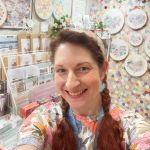I have recently been playing and making samples with Honeycombs, creating tessellated patterns with their perfect match, the square. Of course, I am not the first person to discover how versatile these two shapes are and how they tile and tesselate in so many ways.
Probably the most famous quilt to utilize these two shapes together is Lucy Boston’s Patchwork of the Crosses. Such is its popularity that you are most likely to see at least one Patchwork of the Crosses quilt make an appearance at any guild patchwork show or fair. What is it that makes this quilt so popular? Perhaps it is its step away from working with the more traditional shape of the hexagon. Maybe it is the unique way Ms. Boston used fussy cutting to create even more interest within the design itself.

Patchwork of the Crosses Quilt

Close-up of Patchwork of the Crosses. Some great examples of Lucy’s fussy cutting. Image Source
Lucy Maria Boston was born in England in 1892 and lived to be 97, passing away in 1990. She designed and made approximately twenty amazing patchwork quilts during her long life; however, she is most famous as the author of the Green Knowe children’s books, the setting for which was based on her old manor house Hemingford Grey in Cambridgeshire.
Lucy was born in Southport, Lancashire and was the fifth child of six to James Wood and Mary Garrett. She had two older brothers, two older sisters and a younger brother. During her childhood, Lucy expressed a great love for the countryside in which she lived in. She developed an awareness of plants and gardens, and it is this awareness that led her to create the outstanding and beautiful garden at The Manor.

After finishing school Lucy went to finishing school in Paris. From here she went to Somerville College, Oxford starting in Autumn 1914, during the first months of World War One. She left during her second term to work as a volunteer war nurse. After completing training at St Thomas’s Hospital in London and Addenbrooke’s Hospital in Cambridge, Lucy was posted to a casualty clearing station at Houlgate, Normandy. Here in this tough time Lucy would befriend the wounded soldiers, playing draughts with them in the hope of offering a sense of normality and cheer.
Lucy married her distant cousin Harold Boston in September 1917 and had one son, Peter Shakerley Boston, born September 1918. The marriage did not last however and in 1935 Lucy travelled to France, Italy, Austria and Hungary, visiting the musical capitals of Europe. She studied painting in Vienna and immersed herself in this art form for the next three or four years.
Lucy’s career as a novelist did not start until 1954 when her first book, Yew Hall, a novel for adults was published. Lucy described the novel as “a poem to celebrate my love of the house” referring to the Manor House she bought in 1937. Following this, she wrote a series of children’s books, all set in The Manor. Lucy Lived at The Manor, writing her books and tending her garden for almost 50 years.
Patchwork of the Crosses Quilt on display at The Manor House Hemingford Grey in Cambridgeshire. Image SourceIt was interesting to discover that not much was known of Lucy’s quilts until after her death. Lucy herself only mentions patchwork in ‘Memory in a House’ when she describes repairing an old patchwork hanging in the dining room, in which every piece of material was pre- 1830. The existence of her quilts was not discovered until celebrated conductor and keyboard payer Christopher Hogwood, a close friend, arranged an exhibition of Lucy’s quilts at the King’s Lyn Festival. Lucy’s daughter-in-law, Diana Boston, published the story of the patchworks in The Patchworks of Lucy Boston (1985), using a collection of letters that Lucy wrote to her niece, Caroline Hemming, as well as catalogues and patchwork paraphernalia amongst her possessions.

Hexagon patchwork quilt on display at The Manor House Hemingford Grey in Cambridgeshire. Image Source
I find it intriguing that Lucy’s quilts were not truly celebrated until after her death. I wonder what pleasure if any Lucy took from making her quilts. Did the act of hand stitching bring her peace and comfort during troubled times? Did she feel like the day was not complete without a bit of stitching on her quilts? What inspired her designs? Was it the architecture of the European cities she visited, or was it simply the fabric she used that inspired a design?

Bedroom at The Manor House Hemingford Grey in Cambridgeshire. Image Source
I wonder what secrets, feelings and emotions she stitched into her quilts. Heartbreak, joy, regret, sorrow? If only the fabric patches of her quilts could talk. Lucy said of her quilt making, ‘They ought to be almost like reading poetry, going from one word to the next and making a verse…’
I like this sentiment from Lucy. It shows that Lucy believed in harmony in her quilts. That the fabric and design should work together to create a quilt that is pleasing and whole. I think it proves that Lucy put a lot of thought into the design of her quilts, that she saw them as more than just a utilitarian object.
I myself have not yet fallen down the Patchwork of the Crosses rabbit hole, but I do see a miniature version of it in my future.
I have created a Lucy Boston Pinterest board if you would like some Patchwork of the Crosses inspiration.
https://www.pinterest.com.au/themakersstash/lucy-boston-patchwork-of-the-crosses-quilt/
Books on Lucy Boston:
The Patchworks of Lucy Boston by Diana Boston
Lucy Boston Patchwork of the Crosses by Linda Franz
Happy Stitching,
Miss Leela






